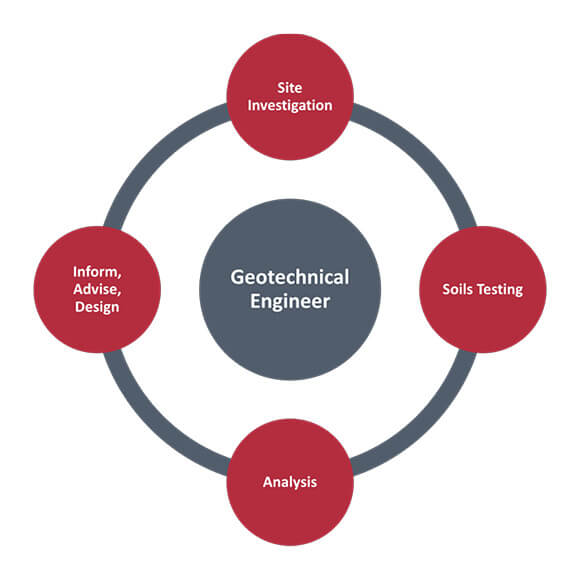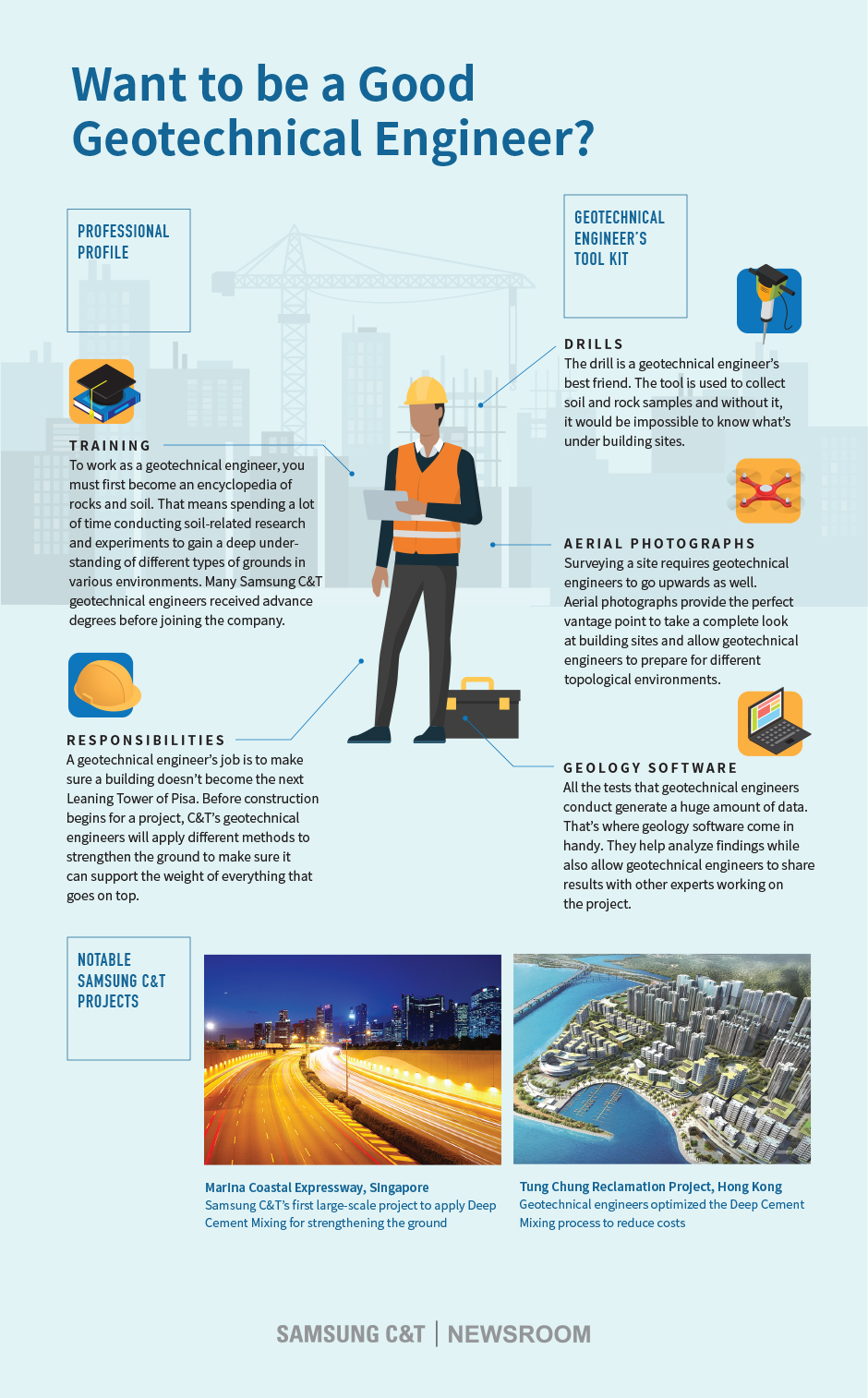The 10-Second Trick For Geotheta
The 10-Second Trick For Geotheta
Blog Article
Geotheta Can Be Fun For Anyone
Table of ContentsWhat Does Geotheta Do?The Only Guide to GeothetaExcitement About GeothetaA Biased View of Geotheta6 Simple Techniques For Geotheta

They perform site investigations, collect examples, execute laboratory tests, and examine information to evaluate the viability of the ground for building jobs - Consulting Engineers. Based on their findings, geotechnical engineers supply referrals for foundation design, slope stability, keeping structures, and reduction of geotechnical dangers. They team up with various other specialists, such as architects, architectural designers, and construction groups, to make certain that geotechnical considerations are incorporated right into the total task style and implementation
By analyzing the actions and buildings of dirt and rock, they can recognize prospective geotechnical dangers such as landslides, soil settlement, or incline instability. Their competence aids avoid failures or mishaps that might threaten lives and residential or commercial property. Right here are some detailed responsibilities and responsibilities of a geotechnical engineer: Website Examination: Geotechnical engineers conduct site examinations to collect data on subsurface conditions.
They translate the information to comprehend the buildings and actions of the dirt and rock, including their toughness, leaks in the structure, compaction features, and groundwater problems. Geotechnical Analysis and Layout: Geotechnical designers analyze the information gathered during site investigations to analyze the security and viability of the site for building and construction projects. They do geotechnical calculations and modeling to review factors such as bearing capability, negotiation, slope security, side planet pressures, and groundwater circulation.
What Does Geotheta Mean?
Foundation Design: Geotechnical engineers play an essential duty in designing foundations that can securely support the desired framework. They assess the soil problems and lots requirements to establish the appropriate foundation kind, such as shallow structures (e.g., grounds), deep structures (e.g (https://www.twitch.tv/geotheta/about)., stacks), or specialized techniques like dirt improvement. They consider factors such as settlement restrictions, bearing capacity, and soil-structure interaction to establish optimal foundation layouts
They examine construction strategies, display site tasks, and conduct field evaluations to validate that the layout referrals are followed. If unanticipated geotechnical issues arise, they examine the scenario and provide referrals for remediation or changes to the style. Danger Analysis and Mitigation: Geotechnical designers analyze geotechnical threats and threats connected with the task site, such as landslides, liquefaction, or soil erosion.

Cooperation and Communication: Geotechnical designers work carefully with various other specialists associated with a task, such as architects, architectural designers, and building and construction groups. Reliable interaction and partnership are vital to integrate geotechnical factors to consider into the total job design and building process. Geotechnical engineers give technical know-how, answer inquiries, and make sure that geotechnical demands are fulfilled.
A Biased View of Geotheta
Here are some kinds of geotechnical engineers: Foundation Designer: Foundation engineers focus on developing and evaluating foundations for frameworks. They analyze the soil conditions, tons needs, and website attributes to identify one of the most appropriate structure type and design, such as superficial structures, deep foundations, or specialized methods like stack foundations.
They examine the aspects affecting incline security, such as dirt residential or commercial properties, groundwater problems, and slope geometry, and develop strategies to avoid slope failures and minimize dangers. Quake Designer: Quake designers concentrate on examining and designing frameworks to withstand seismic pressures. They analyze the seismic danger of a website, evaluate dirt liquefaction possibility, and establish seismic style criteria to make sure the security and durability of structures throughout earthquakes.
They carry out field testing, accumulate examples, and evaluate the collected information to identify the dirt properties, geologic developments, and groundwater problems at a site. Geotechnical Instrumentation Engineer: Geotechnical instrumentation engineers focus on tracking and measuring the behavior of dirt, rock, and frameworks. They set up and maintain instrumentation systems that check aspects such as soil negotiation, groundwater levels, incline activities, and architectural variations to assess efficiency and supply early warnings of possible problems.
8 Simple Techniques For Geotheta
They conduct examinations such as triaxial examinations, combination examinations, direct shear tests, and leaks in the structure tests to collect information for geotechnical evaluation and style. Geosynthetics Designer: Geosynthetics designers focus on the style and application of geosynthetic products, such as geotextiles, geogrids, and geomembranes. They use these products to boost dirt security, enhance slopes, offer drain solutions, and control erosion.
They have a tendency to be investigative individuals, which means they're intellectual, introspective, and analytical. They are curious, their website methodical, reasonable, analytical, and rational. Some of them are additionally social, meaning they're kind, charitable, cooperative, individual, caring, valuable, compassionate, tactful, and pleasant - Tailings Engineer.
In the office atmosphere, geotechnical engineers utilize specialized software devices to do estimations, produce designs, and evaluate information. They prepare records, evaluation job specifications, connect with customers and employee, and coordinate project activities. The workplace setting gives a conducive environment for research, evaluation, and partnership with various other experts associated with the project.
More About Geotheta
They regularly visit job websites to conduct website examinations, examine geotechnical problems, and gather information for analysis. These gos to entail traveling to different areas, in some cases in remote or difficult surfaces. Geotechnical designers may carry out dirt tasting, conduct examinations, and display construction tasks to make sure that the geotechnical facets of the project are being applied correctly.
Geotechnical designers additionally work in specialized geotechnical labs. In these centers, they conduct experiments, carry out examinations on soil and rock samples, and examine the engineering properties of the materials. Geotechnical lab designers work extensively in these settings, handling testing devices, running instruments, and taping information. They work together with various other laboratory staff to make sure precise and trusted screening outcomes.
Report this page